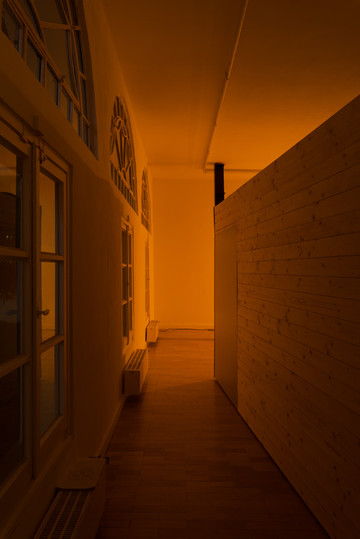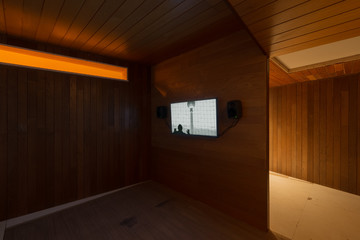Richard Sides’ work is medium non-specific and often explores improvisation. Some recurring techniques include video works, expansive collage techniques, and inhabitable environments and structures. Media images and other found objects are used by Sides in these processes, borrowing from the initial application of images and commodity worlds.
Richard Sides, Bounce their music across the grass, 2021, Kunstverein Hannover
While Sides demonstrates to us the paradox of this state of being „in-between“, along with the cult of mediation that currently rages through our markets, codes, and relationships, even the „media-polemic beating to death of an opponent“ he does not attempt to come down on one side of any heated debate with his art. In full knowledge that criticality and artistic autonomy have long since been incorporated into the plastic sphere of value (say hello to „the new spirit of capitalism“), he does not offer any platitudes of technophilic intoxication or technophobia. On the contrary, Sides makes transparent use of technology in his networked and de-centralized space, by acknowledging their frameworks and what is codified within them. In doing so, he mirrors the tendency of sampling and memes and their creative replicatory genesis, where creation goes hand in hand with imitation and alteration, thereby leading to the irritating ambiguity of a degraded form of communication, one that lacks understanding. That he rarely acts alone in doing so, and more often collectively, ultimately serves as recognition of the necessity of community.
Elisa R. Linn, Ars-Viva 2020, 2020
Richard Sides, Dwelling, 2019, Kunstverein Braunschweig, Braunschweig, Germany
In “Dwelling,” Richard Sides plays with both meanings of the exhibition title as home and thinking. In the venue’s main room is a wooden pavilion, all internal surface and covered with untreated tongue-and-groove paneling. Inside is a newly commissioned hour-long video, Midnight in a Perfect World, 2019, which stages two sets of conversations in a dark comic parody of self-helpy jargon and “alternative” living practices. One character, awake for fourteen days, recounts his escape from a cult-like “parasite pod” community in which the leader, Mark, “introduced us to a sort of vicarious … telepathy where he started thinking for us.” Later, pointing to the corporate intrusion of interior dwelling space, another character sits, eyes closed, listening to an introductory session of Headspace, one of the best-known meditation apps.
A sodium outdoor floodlight beams over the structure and leaks outside to illuminate the courtyard, complicating the sense between indoors and out. On the gallery lawn is a freestanding, featureless wedge, clad on all sides in plywood, paint, and concrete. The structure is defined as a “folly”: a decorative building with no accessible inside or practical purpose. In an inversion of the structure’s traditional use, Sides’s offers no ornamental embellishments, but instead functions as a punctuation and contrast to the Kunstverein’s classicist architecture while infringing on the communal green space and blocking the exterior view. Sides makes clear that attempts at reworking structures or stripping elements away are only ever rearrangements of forms of enclosure, whether in social space or within the self. Both the video and architectural units wryly convey contemporary anxieties around the commons, while collapsing the internal and external, public and private, and individual and communal ideas of dwelling.
— Tim Steer, Critic’s picks, Artforum, 2020

Richard Sides
Untitled (Drew Barrymore digital ultraviolence DRUGS City life Keep calm…), 2018
laminated mixed media
60 × 42,5 cm

Richard Sides
Diavolo, 2021
cardboard, wood, metal, resin
90 × 85 × 30 cm
“His multifaceted output in video, installation, sound, performance and collage blurs seamlessly allowing characters and abstract notions of consciousness to emerge from the complex social composite environments he creates in his work.“
Anna Gritz, Cura Magazine, 2014

Richard Sides
The Daily Mirror, 2021
Installation with two-channel HD video (58:52min), sound, mirror, carpet, wood
Installation View at Fluentum Collection, Berlin

Richard Sides
The Daily Mirror, 2021
Installation with two-channel HD video (58:52min), sound, mirror, carpet, wood
Installation View at Fluentum Collection, Berlin
While Sides prodded at several salient issues – political and economic crisis, say, or violence in different forms – he did so without taking the role of the artist as spokesperson too seriously. This might seem facetious, but it is also where the strength of these works lay. In a period where two stances – aloof formalism or the earnest rhetoric of much so-called political art – seem to be polarizing artistic practices, Sides’s interplay of materials and ideas managed to dip into both and commit to neither, making space for the viewers to speculate without patting himself on the back for doing so.
Lorena Muñoz-Alonso, Frieze Magazine, 2014

Richard Sides
2 x Bridget Riley-style Op Art & FLAT EARTH, 2022
acrylic and varnish on mdf, clamp folder with laminated mixed media, artist made aluminum
90 × 120 cm

Richard Sides
Trash Atlas, 2021
Card packaging, wood, foam insulation, resin, acrylic paint
75 × 170 × 45 cm

Richard Sides
Stern, 2021
acrylic on canvas, magazine pages
100 × 100 cm













